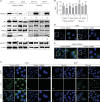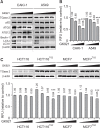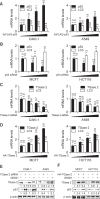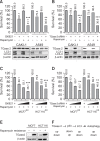Transglutaminase 2 Promotes Autophagy by LC3 Induction through p53 Depletion in Cancer Cell
- PMID: 30231606
- PMCID: PMC6319544
- DOI: 10.4062/biomolther.2018.140
Transglutaminase 2 Promotes Autophagy by LC3 Induction through p53 Depletion in Cancer Cell
Abstract
Transglutaminase 2 (TGase 2) plays a key role in p53 regulation, depleting p53 tumor suppressor through autophagy in renal cell carcinoma. We found that microtubule-associated protein 1A/1B-light chain 3 (LC3), a hallmark of autophagy, were tightly associated with the level of TGase 2 in cancer cells. TGase 2 overexpression increased LC3 levels, and TGase 2 knockdown decreased LC3 levels in cancer cells. Transcript abundance of LC3 was inversely correlated with level of wild type p53. TGase 2 knockdown using siRNA, or TGase 2 inhibition using GK921 significantly reduced autophagy through reduction of LC3 transcription, which was followed by restoration of p53 levels in cancer cells. TGase 2 overexpression promoted the autophagy process by LC3 induction, which was correlated with p53 depletion in cancer cells. Rapamycin-resistant cancer cells also showed higher expression of LC3 compared to the rapamycin-sensitive cancer cells, which was tightly correlated with TGase 2 levels. TGase 2 knockdown or TGase 2 inhibition sensitized rapamycin-resistant cancer cells to drug treatment. In summary, TGase 2 induces drug resistance by potentiating autophagy through LC3 induction via p53 regulation in cancer.
Keywords: Autophagy; Cancer cell; LC3; Transglutaminase 2; p53.
Figures




Similar articles
-
Renal cell carcinoma escapes death by p53 depletion through transglutaminase 2-chaperoned autophagy.Cell Death Dis. 2016 Mar 31;7(3):e2163. doi: 10.1038/cddis.2016.14. Cell Death Dis. 2016. PMID: 27031960 Free PMC article.
-
Transglutaminase 2 inhibition found to induce p53 mediated apoptosis in renal cell carcinoma.FASEB J. 2013 Sep;27(9):3487-95. doi: 10.1096/fj.12-224220. Epub 2013 May 23. FASEB J. 2013. PMID: 23704086
-
Allosteric inhibition site of transglutaminase 2 is unveiled in the N terminus.Amino Acids. 2018 Nov;50(11):1583-1594. doi: 10.1007/s00726-018-2635-2. Epub 2018 Aug 14. Amino Acids. 2018. PMID: 30105541
-
Inhibition of Transglutaminase 2 but Not of MDM2 Has a Significant Therapeutic Effect on Renal Cell Carcinoma.Cells. 2020 Jun 16;9(6):1475. doi: 10.3390/cells9061475. Cells. 2020. PMID: 32560270 Free PMC article.
-
New Insights into Development of Transglutaminase 2 Inhibitors as Pharmaceutical Lead Compounds.Med Sci (Basel). 2018 Oct 8;6(4):87. doi: 10.3390/medsci6040087. Med Sci (Basel). 2018. PMID: 30297644 Free PMC article. Review.
Cited by
-
Type 2 transglutaminase in the nucleus: the new epigenetic face of a cytoplasmic enzyme.Cell Mol Life Sci. 2023 Jan 25;80(2):52. doi: 10.1007/s00018-023-04698-8. Cell Mol Life Sci. 2023. PMID: 36695883 Free PMC article. Review.
-
Cryptotanshinone Inhibits the Growth of HCT116 Colorectal Cancer Cells Through Endoplasmic Reticulum Stress-Mediated Autophagy.Front Pharmacol. 2021 Jun 17;12:653232. doi: 10.3389/fphar.2021.653232. eCollection 2021. Front Pharmacol. 2021. PMID: 34220498 Free PMC article.
-
The interaction mechanism between autophagy and apoptosis in colon cancer.Transl Oncol. 2020 Dec;13(12):100871. doi: 10.1016/j.tranon.2020.100871. Epub 2020 Sep 18. Transl Oncol. 2020. PMID: 32950931 Free PMC article. Review.
-
A Precision Strategy to Cure Renal Cell Carcinoma by Targeting Transglutaminase 2.Int J Mol Sci. 2020 Apr 3;21(7):2493. doi: 10.3390/ijms21072493. Int J Mol Sci. 2020. PMID: 32260198 Free PMC article. Review.
-
The Gαh/phospholipase C-δ1 interaction promotes autophagosome degradation by activating the Akt/mTORC1 pathway in metastatic triple-negative breast cancer.Aging (Albany NY). 2020 Jul 1;12(13):13023-13037. doi: 10.18632/aging.103390. Epub 2020 Jul 1. Aging (Albany NY). 2020. PMID: 32615541 Free PMC article.
References
-
- Birgisdottir AB, Lamark T, Johansen T. The LIR motif - crucial for selective autophagy. J. Cell Sci. 2013;126:3237–3247. - PubMed
LinkOut - more resources
Full Text Sources
Other Literature Sources
Research Materials
Miscellaneous

